Overclocked: Our Custom Radeon HD 5870 Roundup
by Ryan Smith on May 19, 2010 11:53 AM ESTPower, Temperature, & Noise
Moving on to our look at power, temperature, and noise, we get to finally take a look at what these custom designs can do for these characteristics.
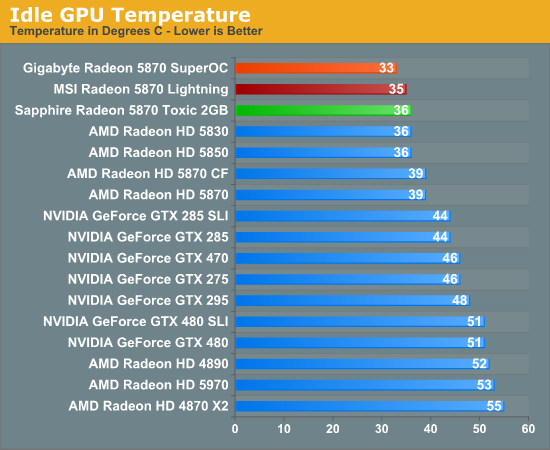
Kicking things off with temperature, we have the idle temperatures of our cards. Regardless of our overclocks, they all idle at the same 0.95v and 150/300 clockspeeds, so this is solely a test of their respective coolers. All 3 of our cards do very well here with their custom coolers, coming in at the top of our charts and beating even our wondrous Radeon 5850. The dual-fan coolers on the MSI and Gigabyte cards end up doing the best here which isn’t surprising. Pay close attention to the Gigabyte card though; 33C comes with a price.
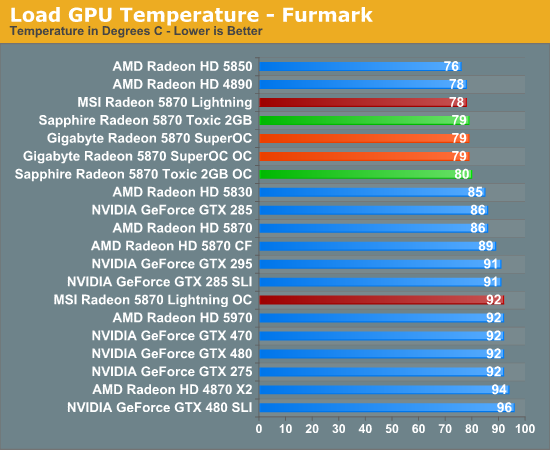
Under load with FurMark we have two different scenarios to look at: stock clocked and overclocked. At stock these are some of the best cards we have ever tested, with the MSI card tying for the second-lowest temperature among our modern cards while the Gigabyte and Sapphire cards tie for 3rd. With these coolers we’re 7-8C under the reference 5870, and ultimately behind only the 5850. Meanwhile overclocking pushes temperatures way up the MSI card – the only card we were able to overvolt to an appreciable level. Here we’re basically hitting in to our self-imposed operational ceiling, with the card settling at 92C for its 940/1300 overclock. The Gigabyte and Sapphire cards, which weren’t stable or lacked overvolting abilities respectively, are effectively unchanged here.
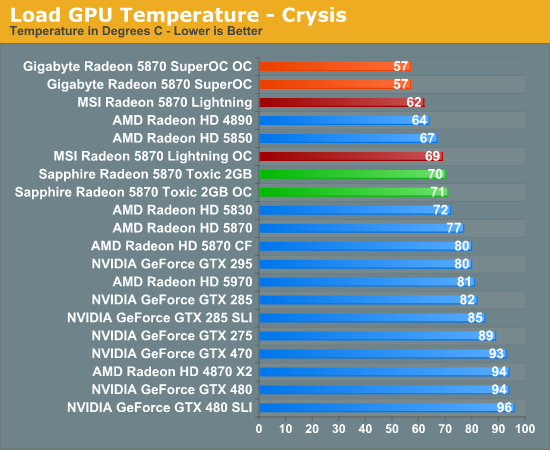
Finally we have another look at load temperatures with Crysis, which isn’t nearly as demanding as FurMark. The results here are quite surprising, as the cluster of cards under FurMark is anything but with Crysis. Topping our chart is the Gigabyte card, bringing in a cool 57C both at stock and overclocked. This is a phenominal result that actually had us retesting it a few different times just to make sure we weren’t making any mistakes – it’s the real deal. Following up the Gigabyte card is the MSI Lightning at 62C stock and 69C overclocked. Finally we have the Sapphire at 70C stock and 71C overclocked, with its worse showing here a combination of the extra heat generated by the extra 1GB of RAM and the use of a single fan in its cooler. All of these cards are well ahead of the reference 5870, playing second-fiddle only to our 5850 and 4890.
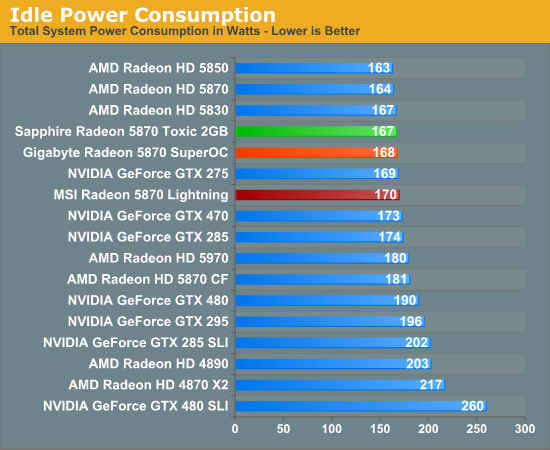
Moving on to power consumption, under idle we see all the cards fall back together. Interestingly we would have expected the Sapphire card to do the worst here due to its 2GB of RAM, but instead it’s the MSI card falling behind by a few watts. Our best guess is that the penalty for all of the MSI Lightning’s extra circuitry is greater than the penalty for the extra RAM on the Sapphire.
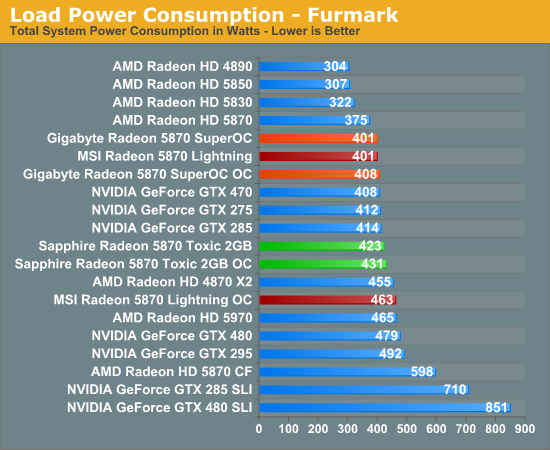
As for load power, our results are once more tightly clustered until overclocking is factored in to the equation. All of these cards draw more power under FurMark than our reference 5870, with the MSI Lightning and Gigabyte Super Overclock both faring the best. The MSI card should have the edge here due to its core voltage advantage over the Gigabyte card, but once again the MSI card appears to be taking a slight hit due to the extra components, erasing that advantage. Meanwhile the Sapphire card is the worst at 423W for its 1.2v core voltage and additional RAM.
Overclocking drives the Sapphire and Gigabyte cards up by a few watts, while the MSi card pays a much higher price due to our overvolting it. At 463W we’re drawing as much power as a pair of Cypress GPUs (the 5970), making the Lightning’s 8pin PCIe power connectors a very good idea at this point.

Our final power test is Crysis, which echos our FurMark results. All of the cards draw at least a bit more than the reference 5870, with the Sapphire once again faring the worst. Overclocking the MSI Lightning once more puts it in 5970 territory, although it’s 9W back this time.

Last but not least we have our look at noise. Right away we can see the Achilles’ Heel of the dual-fan coolers, as they generate far more noise when idling than the reference 5870 does. The Gigabyte card fares extremely poorly here, sharing company solely with our GeForce GTX 295. It goes without saying that this card is very noticeable when idling, something we can’t say about the other cards. We can think of no good reason for the Gigabyte card to be this loud, and this is a major problem for the card.
Meanwhile the MSI card is a few dB back at 46.9, making it one of our louder cards but still in the company of our 4890 and GTX 285. It’s loud enough that in our Thermaltake Spedo case we can hear the card if we try, but it’s still quiet enough to not be a deal breaker. Finally at the top of our chart is the Sapphire Toxic 2GB, which fares extremely well due to its single 92mm fan. In fact it’s the quietest card among our selection of high-end cards, coming within 2dB of our noise floor when we use passively cooled cards.
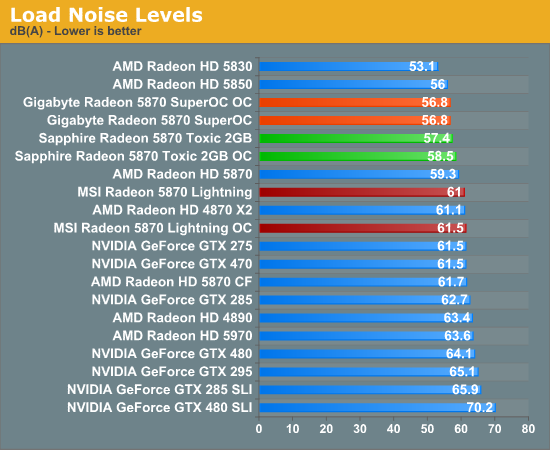
Finally we have our load noise tests under FurMark. Although none of these cards set records, both the Gigabyte and Sapphire cards are near the top of our charts and manage to beat out the reference 5870 by a couple dB. The Gigabyte card in particular is quite surprising since it fared so poorly at idle and packs 2 80mm fans – we would have expected it to be louder. Instead it’s doing 56.8dB at 100% fan speed, so this is as literally as loud as the Gigabyte card can get.
On the other side of the reference 5870 we find the MSI Lightning, which in spite of its similarities to the Gigabyte card comes in a couple of dB louder than said reference 5870. With our overclock of the card it comes to 61.5dB, which like the Gigabyte card is 100% fan speed, so this too is as loud as the card can get. At these levels it’s appreciably louder than the Gigabyte and Sapphire cards, less so compared to the reference 5870, and effectively in the middle of the pack compared to anything but a Radeon 5800 series card.










43 Comments
View All Comments
Jediron - Saturday, May 22, 2010 - link
These are not cards for a gamer, but for people who make it a sport to beat the other guys 3Dmark results.Gamers, you'll see it hardly makes a difference, gameexperience is something else then raw, digital FPS numbers. Save yourself alot of cash and buy a default clocked card; that leaves you with enough money to buy your favorite game ;)
cauchy2k - Thursday, May 20, 2010 - link
People should not take into account this near 100 °C ,becuase you can increase fan speeds and lower temps a lot.hglazm - Thursday, May 20, 2010 - link
Either you got a bad chip with the lightning, got an exceptional chip with the Toxic, or did something wrong when overclocking the lightningBecause both of mine hit 1ghz without issue. As well as three of the four 5770 HAWKs my friends have ordered (one hit 980 instead of 1020-1060).
Ninjahedge - Thursday, May 20, 2010 - link
It is always good to see this kind of thing being made and tested, but the thing that gets me is simple.This aint the Celery 300 days. You can't get the equivalent of a more expensive chip for half the price, boost it to 150% with a simple (was it multiplier?) switch and get 80%-90% of the more expensive brother.
I have not really seen much come out in the past few years that warrants throwing that much cash out on something that will be beaten for $100 less in 6 months.
Especially when there really is no game that would need it.
The fact that the makers are still comcentrating on giving you the fastest card that can show nose-hair and blackheads in 3D at 2560 resolution irritates me. Has there been any progress (or push for progress) in an EFFICIENT card that can do what the 4870, or 5800's can do for half the power? Passive (silent) cooling? Half the PRICE?
It would be great to get a card to use 1 6 pin additional power cable (hell, push it further, NO additional power) that would be able to fit into a compact case (Shuttle?) and not sound like a dust-buster in game.
Good article, but disappointing that this is still the direction card makers are going. (also sad that all that $$, all that noise and heat gets you so little in the end...)
Question, have you guys figured out a way to be able to rate the best Bang for the Watt? Some comparison taking compact, quiet, efficient cards and trying to rank them by speed, efficiency, ergonomics and price? Can that be done or is that too many variables?
mapesdhs - Tuesday, May 25, 2010 - link
Good post! I thoroughly agree. Reminds me of how pleased I was with the performance ofthe X1950 I bought in 2006 for 156 UKP, and then again later the excellent results obtained
from an 8800GT (Gigabyte Zalman, 700MHz core) which was only 120 UKP. Decent prices,
nice performance each time.
Prices now are crazy. I've given up waiting for a card that offers a reasonable speed boost
at any kind of similar price point, so instead I've bagged an extra identical 8800GT to have
SLI which should work quite well until the RAM limit becomes a factor (atm I'm not playing
games which need 1GB). I've done the same thing for my new PC build (i7 860), buying two
8800GTs which cost less than 100 UKP total.
As you say, it seems vendors are going all out for high cost cards, which is ironic given we're
supposed to be in the middle of a global recession. Who has the money to buy a $570 card
and sleep easy? On a tight budget, I managed to get some items 2nd-hand, saved a decent
amount (750W PSU 40% cheaper than new, WD VR 150GB half new price), and found an eBay
seller doing the i7 860 at a good price (205 UKP, almost 30 less than any other source) with
free shipping (item 270583690505; he has 5 left. Mine is only running at 3.8GHz atm, but I don't
have the proper fans yet).
When I bought the 8800GT in 2008, I doubled or tripled games fps rates compared to my old
X1950 using the same CPU/RAM (Athlon64 6000+, 4GB DDR2/800), for less than $200. Two
years on once more, doing the same thing isn't possible.
Ian.
Kaihekoa - Thursday, May 20, 2010 - link
Anandtech really needs to get a reliable proofreader. Every article I read has multiple typos which obviously isn't very professional for such a highly regarded tech site. I would do it for free given the subject matter.austonia - Thursday, May 20, 2010 - link
These cards do not OC very well at all. I have a reference-design Sapphire 5850 from about a month after they came out, and it does 900/1300 at stock 1.08v, and 1000/1300 at 1.25v. You would think these 5870s with cherry-picked chips, high end components and cooling system could at least match a stock 5850. And there were quite a few people on overclock.net forums getting similar results. Anyway thanks Anandtech, good info.austonia - Thursday, May 20, 2010 - link
Please consider adding Metro 2033 to the benchmarks, with all of the eyecandy turned up it looks like a slideshow on my 5850. Must need a brutal amount of power. None of the games you are testing now are very challenging for a Fermi or 5850+.Kaihekoa - Thursday, May 20, 2010 - link
I would like to extend my thanks to Anandtech for doing an article about PC hardware instead of writing laptop reviews and copy/pasting press releases. I believe this is a topic of great interest for gamers and hardware enthusiasts: How much benefit do you get out of these pre-overclocked cards with big price premiums. As we can see you don't get much and certainly not enough to justify paying $100 or more extra. I just upgraded my Radeon 4870 to a 5850 that overclocks to 950/5000 without extra voltage. Oh, and I paid $225 for it on ebay meaning I got almost as much performance as these $500 cards for 55% less money.Etern205 - Friday, May 21, 2010 - link
Why no this?http://vr-zone.com/articles/retail-asus-matrix-587...